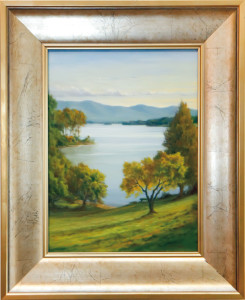 Aesthetic tastes are personal, and often secretly shaped by our subconscious. But any collector can intentionally decide to invest in original art and determine what sort of tone to set for a room. While the specifics of local residents’ taste may differ, one thing unites us all: our affection for the beautiful Smith Mountain Lake. And both two- and three-dimensional pieces have the potential to communicate that love.
Aesthetic tastes are personal, and often secretly shaped by our subconscious. But any collector can intentionally decide to invest in original art and determine what sort of tone to set for a room. While the specifics of local residents’ taste may differ, one thing unites us all: our affection for the beautiful Smith Mountain Lake. And both two- and three-dimensional pieces have the potential to communicate that love.
“People are attracted to the natural beauty of the lake,” says Pam Bryant, current owner of The Little Gallery in Bridgewater Plaza. “It’s the reason they came here. And they want art that reflects that.”
The Little Gallery features a collection of works by more than 200 artists and has served the region’s fine art needs since 1988. Offering pottery, jewelry, stained glass, paintings and more, the shop’s charming hoard reflects the eclectic taste of the greater community’s homeowners, from full-timers to semi-annual vacationers. As an American Society of Interior Decorators industry partner, The Little Gallery also provides knowledgeable art consultation for residential and commercial locations.
Locals may pay homage to the lake by choosing any number of related subjects, from lakescapes to nearby landscapes to nature art, all of which Bryant describes as “soothing and healing and uplifting.”
The Little Gallery represents several artists who specialize in figurative lake and landscape art well-suited to homes in the region, such as Greg Osterhaus, Ed Hatch and Tim Pfeiffer.
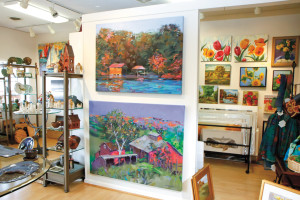 Among these masters of figurativism is David Heath, an artist represented by The Little Gallery. Having built a respected international career depicting the scenes from Blue Ridge Mountains and coastal Virginia and North Carolina, Heath studied 19th-century American landscape painting before finessing his own style. His ethereal interpretations of Mother Nature are sought after by American, European and Asian collectors and have earned numerous accolades. Thanks to the United States Art in Embassies program, Heath’s paintings have journeyed abroad to the United Arab Emirates and Senegal.
Among these masters of figurativism is David Heath, an artist represented by The Little Gallery. Having built a respected international career depicting the scenes from Blue Ridge Mountains and coastal Virginia and North Carolina, Heath studied 19th-century American landscape painting before finessing his own style. His ethereal interpretations of Mother Nature are sought after by American, European and Asian collectors and have earned numerous accolades. Thanks to the United States Art in Embassies program, Heath’s paintings have journeyed abroad to the United Arab Emirates and Senegal.
Closer to home, his paintings have been recognized by the Lynchburg Museum, the Central Virginia Chapter of the Virginia Museum of Fine Arts and the Roanoke Museum of Fine Arts (now the Taubman Museum of Fine Art), among others. Heath now makes his home in Smith Mountain Lake—what he calls “the culmination of a lifelong dream”—and has lived here for 18 years.
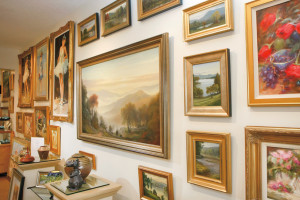 As an artist, Heath has strong opinions about art and home decorating, stating that private collections should bring owners happiness.
As an artist, Heath has strong opinions about art and home decorating, stating that private collections should bring owners happiness.
“The visual experience of the lake is one which constantly inspires me and brings joy and fulfillment in my life,” says Heath. “I would think that most people choose to live here for similar reasons and most art is chosen on the basis of what a person values or loves.”
He also urges collectors to opt for original art. “The atmosphere, depth and texture of an original work are vital elements necessary to the experience of true art appreciation,” says Heath.
Take, for instance, the raku of Little Gallery’s Dave Ovenshire or Charlotte Munning. These handcrafted ceramics in the Japanese tradition are uniquely multidimensional and incomparable to department store ceramics.
Bryant believes that original works, unlike prints or production pieces, are endowed with an aura because they were birthed out of the artist’s personal mood and inspiration. This aura imbues the collector’s home. “Original art enhances the room and lifts the mood, or creates the room’s mood and energy,” says Bryant.
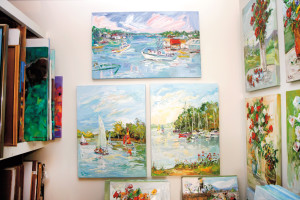 She also mentions that purchasing original art by living individuals supports their quest to be professional, full-time artists. Over time, original art increases in value, and has the potential to become a family heirloom that lifts the spirits of multiple generations.
She also mentions that purchasing original art by living individuals supports their quest to be professional, full-time artists. Over time, original art increases in value, and has the potential to become a family heirloom that lifts the spirits of multiple generations.
One of Bryant’s top pro tips is to choose a piece of art first and to then design the rest of the room around it. (With three-dimensional works, such as Brian Arthur’s bronze dogs or Michael Alfano’s faux bronze sculptures, “around” will have to be interpreted more literally.)
Heath agrees, saying, “It seems that most often in decorating, the other elements of design, such as paint colors, furniture and textiles, are chosen first, limiting the choices of artwork to that which best complements the overall scheme. As an artist, my preference would be that the art would be of equal importance to the overall design.”
Bryant advises art collectors to consider wall space when decorating, noting that windows abound at lake homes. “It’s very important to determine how much space you have available in order to search for the right pieces at the right size,” she says.
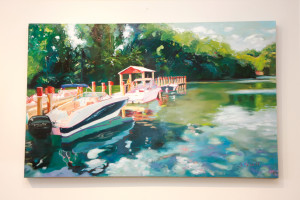 According to Bryant, many designers recommend that artwork fill two-thirds to three-fourths of a wall. To maximize the impact of contemporary art—especially colorful or mixed media pieces, such as pieces by Little Gallery artists Portia and Barbara Burlingame—go bigger. This advice also goes for sculptures.
According to Bryant, many designers recommend that artwork fill two-thirds to three-fourths of a wall. To maximize the impact of contemporary art—especially colorful or mixed media pieces, such as pieces by Little Gallery artists Portia and Barbara Burlingame—go bigger. This advice also goes for sculptures.
And when it comes to the hanging process, one that is so easily botched? Center the work at eye level and make sure it’s at least six to 12 inches above any furniture. Then sit back and admire your exquisite bounty.
Bryant encourages potential collectors to ask lots of questions when shopping for art. “Whatever mood or look you’re trying to create, the art gallery should be helpful and friendly,” she says. “You should never be concerned about not knowing art or asking questions. A gallery is there to help you learn art, to learn about the artists and their credentials, and find the right pieces that speak to you.”
